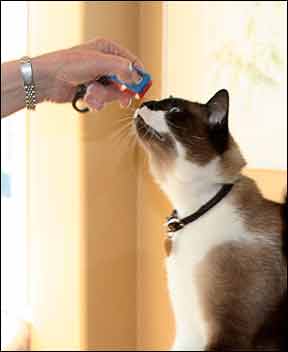There’s a lighthearted saying that goes something like this: “Dogs come when called. Cats take a message and get back to you.” For anyone who has ever shared their home with both canine and feline friends, you know this statement is true! But it doesn’t have to be that way. You can use a training method like “clicker training” or “target training” to reward your cat when she performs a certain task.

288
The clicker [an inexpensive, hand-held device that makes a distinct “clicking” sound] can tell a cat that she just did something her person liked and a treat is coming. For instance, if you want your cat to touch her nose with her paw, wait until she does it — then immediately “click” and give her a favorite treat.
Target training involves using your cat’s natural curiosity to investigate a “target” such as your finger, a pen or a spoon. When your cat engages in a desired behavior (such as touching her nose or coming up to you), “click” and give a food reward. After several trials, she will begin to associate the act with a reward. You can then begin pairing the action with a command such as “touch” or “come.”
Keep in mind that timing is an important component of training cats. They usually aren’t motivated to perform on cue and they take their time sniffing a treat before eating it, whereas a dog will gobble it up. By the time a cat eats the treat, she no longer associates a treat with the action performed. That’s why many experts feel that clicker training is particularly effective with cats — it gives them immediate feedback.
Reasons to Train Your Cat. There are times when it’s important that your cat come to you when called. For example, when: An indoor-only cat slips outside; An emergency such as a fire forces a hasty evacuation; You’re leaving the house and want to do a “roll call” to ensure all your cats are safe.
Training a cat is easier than you think — as long as treats are involved! There are many healthy, tasty treats on the market, so experiment until you find one that your cat just can’t resist (those made from real meat or dairy often work well). Next, develop a call, preferably something short and simple. It can be as straightforward as stating her name (“Bella, treat!”). If your cat responds to the sound of a can or bag of food being opened (most cats do), then use this to your advantage by shaking a pouch of treats and calling your cat’s name. Try using a slightly higher voice as cats are naturally attuned to high-pitched sounds. If more than one person in your household is training your cat, make sure everyone is using the same word or phrase to call your cat over to you. It’s important that you reserve this call for training purposes only so as not to confuse your cat.
As with all animals, never punish your cat for coming to you. If you get angry and yell at her because she took her time coming over to you, she will be less likely to repeat the behavior in the future. Always reward your cat with a treat, playtime, or petting and you’ll have a happier, better behaved cat.
Putting It All Together. When you first start training your cat to come to you, it’s important that you run through the exercise once or twice a day until your cat has mastered “come.” Then you can taper off until you’re just running through the drill once a week for practice. With a little patience and practice, your cat can learn this important — and potentially lifesaving — skill.



